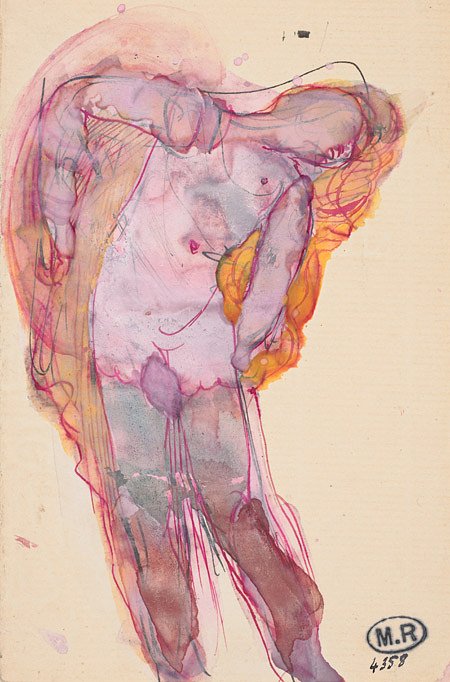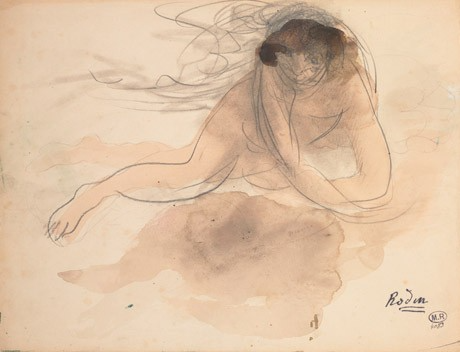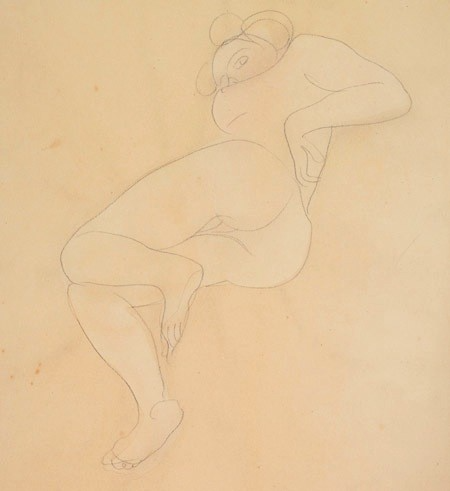Rodin's Drawings

Tue 13 Mar 2012

Nuage. Photo: Jean de Calan/© Musée Rodin.
To experience “Capturing the Model” at the Musée Rodin in Paris, an exhibition of Auguste Rodin’s drawings from the final two decades of his life, is to discover this familiar French artist through a different medium and to follow an evolution of his talent from raw observation to a fully realized form of art.
Many people aren’t aware of Rodin’s accomplishments as a drawer. Surely this stage is where each sculptor must begin, but at the end of his life, Rodin dedicated himself daily to the drawing of live models and established himself not only as the genius sculptor of sensual, tortured forms but also as a talented sketcher, securing his reputation as one of the greatest artists of his time.
An exhibition of Rodin’s drawings is the perfect consolation for the museum’s being closed for renovation until April—if you can’t see his sculpture beyond the museum’s famous gardens, find comfort in the chance to see this incredible collection of Rodin works from a different, more colorful perspective.

Femme nue étendue sur le côté. Photo: Jean de Calan/© Musée Rodin.
“Capturing the Model” begins with Rodin’s simplest and most visceral sketches. You know that feeling when you’re looking at a Rodin sculpture and it’s almost as if the figure is rising out of the marble, coming alive before you from its rough and unpolished base to its perfectly realized, emotional peak? Rodin’s drawings echo this tendency, emerging from the page with that same familiar burst of energy. Rodin would draw his live model almost recklessly, not looking at the page and scarcely lifting his pencil from the page, perhaps adding color later. These drawings give merely the illusion of shape, and retain not the careful, finished look of a perfectionist’s work but the wild freedom of an artist who still sees the world with fresh eyes. Through his raw strokes, Rodin achieves a compelling immediacy in his clear appreciation for the reality of form, the ephemera of movement. Faces are almost childlike in their simplicity; watercolors bleed hair into flesh, and their bold shades, unnatural in shocking shades of hot pink and purple, abstract the forms and give them even more life. The sketches are quick, emotional, like versions and versions of sight transposed over each other for so much movement.

Femme nue dans ses voiles. Photo: Jean de Calan/© Musée Rodin.
Later, Rodin would repeat and refine some figures into a single line or create assemblages combining several sketches, enlacing figures with each other and giving a different dynamism to the drawings. Seeing this cut-and-paste technique is like watching the artist at play—we watch him experiment, and new forms begin to emerge before us as he creates silhouettes of paper against paper, abstracting the image with color, as though he’s sculpting with two dimensions now instead of three.
There is a set of three drawings juxtaposed with each other that look nearly identical: two-color silhouettes in elongated arches. Yet their titles reveal them to be of very different perspectives: one is a model standing, her head back, long hair hanging down; one is a woman from the frontal view, her legs spread open (leg-head-leg forming the arch); and the third is a model in profile, her entire body bent back in an arch.

Femme accroupie vue de dos, un vêtement sur les épaules. Photo: Jean de Calan/© Musée Rodin
The exhibition is divided into sections, from Rodin’s drawings reminiscent of the Greek and Japanese styles (flat color, uncomplicated lines) to his architectural series (as in A Woman Like a Vase) to his sketches inspired by myth and metamorphoses. But in each series, Rodin’s drawings share something in common besides their impulsive and dynamic nature. Each drawing contains a kind of vivacious eroticism, many rather explicit, in which we can see how Rodin’s careful observation of the human form allowed him to sculpt with truth the hunching, hulking, stretching, taut bodies of his career (though the majority of his sculpture is missing the pudenda so prevalent in his sketches). Indeed, Femme accroupie vue de dos, un vêtement sur les épaules shows us clear echoes of Rodin’s Je Suis Belle. The exhibition’s range from simplistic, quick sketches to intensely expressive facial portraits gives us a view into the full spectrum of the sculptural tendencies and unmitigated spirit of the artist.
The final section of the exhibition seems to combine all aspects displayed in “Capturing the Model”—the sensuality of the figures before him, the immediacy of stroke, the fearless use of unnatural color—and returns the viewer to seeing Rodin as we know him best: as the complex, creative thinker that he was.
Be sure to see “Capturing the Model” tout de suite, as the exhibition closes April 1.
Related Link
“Capturing the Model”
Editor’s note: There are so many wonderful, offbeat and unusual trips and trip guides in Paris, many of which are our partners in the GG2P Travel Club. All our trip partners offer members a discount or VIP treatment.